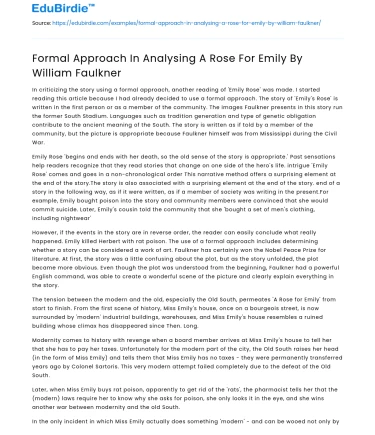In criticizing the story using a formal approach, another reading of 'Emily Rose' was made. I started reading this article because I had already decided to use a formal approach. The story of 'Emily's Rose' is written in the first person or as a member of the community. The images Faulkner presents in this story run the former South Stadium. Languages such as tradition generation and type of genetic obligation contribute to the ancient meaning of the South. The story is written as if told by a member of the community, but the picture is appropriate because Faulkner himself was from Mississippi during the Civil War.
Emily Rose 'begins and ends with her death, so the old sense of the story is appropriate.' Past sensations help readers recognize that they read stories that change on one side of the hero's life. intrigue 'Emily Rose' comes and goes in a non-chronological order This narrative method offers a surprising element at the end of the story.The story is also associated with a surprising element at the end of the story. end of a story in the following way, as if it were written, as if a member of society was writing in the present.For example, Emily bought poison into the story and community members were convinced that she would commit suicide. Later, Emily's cousin told the community that she 'bought a set of men's clothing, including nightwear'
Save your time!
We can take care of your essay
- Proper editing and formatting
- Free revision, title page, and bibliography
- Flexible prices and money-back guarantee
However, if the events in the story are in reverse order, the reader can easily conclude what really happened. Emily killed Herbert with rat poison. The use of a formal approach includes determining whether a story can be considered a work of art. Faulkner has certainly won the Nobel Peace Prize for literature. At first, the story was a little confusing about the plot, but as the story unfolded, the plot became more obvious. Even though the plot was understood from the beginning, Faulkner had a powerful English command, was able to create a wonderful scene of the picture and clearly explain everything in the story.
The tension between the modern and the old, especially the Old South, permeates 'A Rose for Emily' from start to finish. From the first scene of history, Miss Emily's house, once on a bourgeois street, is now surrounded by 'modern' industrial buildings, warehouses, and Miss Emily's house resembles a ruined building whose climax has disappeared since Then. Long.
Modernity comes to history with revenge when a board member arrives at Miss Emily's house to tell her that she has to pay her taxes. Unfortunately for the modern part of the city, the Old South raises her head (in the form of Miss Emily) and tells them that Miss Emily has no taxes - they were permanently transferred years ago by Colonel Sartoris. This very modern attempt failed completely due to the defeat of the Old South.
Later, when Miss Emily buys rat poison, apparently to get rid of the 'rats', the pharmacist tells her that the (modern) laws require her to know why she asks for poison, she only looks it in the eye, and she wins another war between modernity and the old South.
In the only incident in which Miss Emily actually does something 'modern' - and can be wooed not only by a worker, but also by a Yankee - the inhabitants of the city adopt very old Southern attitudes and in fact try to bring the parents to something Sense p to speak. in Miss Emily, to make her behave like the Southern aristocratic, she always is. This also fails completely, another defeat, but this time the conflict tilts on her side, fighting with Miss Emily to be modern, and the city tries to keep the old South alive.
The analysis of Emily's rose 'William Faulkner's rose for Emily', the death of Miss Emily Gleason, the protagonist of the story, begins and ends. In the story, William Faulkner uses the characterization to reveal the character of Miss Emily. Faulkner expresses Miss Emily's character through explanation, actions, words, feelings, direct comments to the speaker and actions, words, feelings of the other characters.
Victorian women and 'Emily's Rose' by William Faulkner and 'Storm' by Kate Chopin. There is something on a blank page that makes your emotions and emotions flow without judgment. This is your own creature, a creature still hurt by the opinions of others. The sensation of these recordings allows unlimited access to the author's perspective. That is why we have a unique interview about the idea of the authors and their personal vision of the conflict between two unique Victorian women.
The analysis of Emily's rose 'William Faulkner's rose for Emily', the death of Miss Emily Gleason, the protagonist of the story, begins and ends. In the story, William Faulkner uses the characterization to reveal the character of Miss Emily. Faulkner divides the story into 'five parts, the first and the last, now the story, and the three intermediate parts explain in detail the past' (Davis 35). Faulkner expresses Miss Emily's character through explanation, actions, words, feelings, direct comments to the speaker and actions, words, feelings of the other characters.
The story of Miss Emily Grissen, who analyzed 'Amy Rose' by William Faulkner of Miss Emily Grison. She was born in a rich family in Jefferson. She grew up and lived with a maid in a large Victorian house. After the end of the civil war, his family's fortune seems to be deteriorating, but Griselson is still trapped in family wealth.






 Stuck on your essay?
Stuck on your essay?

